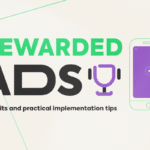Rewarded Ads: Benefits and Practical Implementation Tips
Unlock Exciting Rewards: Engage with Rewarded Ads Today!

Rewarded Ads are a type of incentive-based advertising and a crucial resource for advertisers, publishers, and app developers to maintain user interest in ads.
If you are a Grumft ad partner, welcome to our blog! If you are not yet, we hope this content motivates you to explore our exclusive programmatic solutions for publishers, app developers, and advertisers. In this article, you’ll learn about Rewarded Ad format, its key advantages, and how to implement it in your app.
What are Rewarded Ads?
Rewarded Ads offer users the opportunity to interact with a playable ad in exchange for an incentive, such as an extra life in a game, an extended free trial, a tip, or virtual currency.
In each Rewarded Ads funnel, four main events can occur:
- Ad prompt: the user is presented with the option to view an ad in exchange for an incentive.
- Opt-in: when the user chooses to interact with the ad.
- Ad Reward: the user completes ad viewing and receives a reward.
- Item used: when the user consumes the reward and can continue playing from where they left off.
As users want to continue playing, they generally convert throughout the entire funnel.
Why Use Rewarded Ads?
With increasing competition in the mobile gaming market, developers need to focus on engagement and retention. Finding the right balance between monetization and user experience is crucial for app success.
Rewarded Ads are a way to achieve this balance. According to a Unity Ads study, video Rewarded Ads for apps have impressive success rates:
- 71% of players prefer in-game video ads over paid apps or in-app purchases.
- 54% of players specify that Rewarded video ads are their preferred video ads in the game. 62% of players regularly choose to voluntarily engage with Rewarded video apps.
- 62% of developers saw user retention maintain or increase after introducing Rewarded video ads.
- 52% of mobile game developers said that Rewarded video apps served as their most lucrative type of in-game advertising, per user.
The success rates can be attributed to Rewarded Ads because they help users progress in the app for free. Instead of paying with money, users can “pay” with time and attention to gain benefits that help them continue playing, progress faster, or receive advantages that would otherwise be paid for.
Rewarded Ads give users the possibility to be in control of the experience when they have the option to interact with ads or not.
Benefits of Rewarded Ads
An app achieves its goal when it can generate revenue, provide an excellent user experience, and engage users with advertisers. In this sense, Rewarded Ads offer benefits to all involved parties:
Users
- Ability to choose when to interact with the ad: Rewarded Ads should never play automatically.
- Rewards for interacting with ads: ads are always accompanied by an incentive.
- Lower prices or fewer money-requiring purchases: users buy resources and benefits with their time and attention.
Publishers and Developers
- Higher user retention rates: users are less likely to get frustrated and quit the app if they have the opportunity to interact with ads to earn tips, extra lives, or other rewards.
- Up to 80% of users opt for advertising: more users choose to interact with ads when they don’t need to make direct in-app purchases.
- Increased downloads: if an app is free for the user and the publisher or developer earns money through Rewarded Ads, more users may download the app.
Advertisers
- Higher completion rates for ad views: the user is not rewarded unless the ad is fully viewed, making it unlikely for the ad to be ignored or skipped.
- Better audience targeting: users are likely to choose to watch ads that interest them.
- Higher viewer satisfaction: Rewarded Ads are optional and non-intrusive, favoring user views towards advertisers.
Best Practices for Rewarded Ads
Factors such as implementation, design, or positioning affect the performance of Rewarded Ads. Check out some tips and features that can help:
Ad positioning
How you implement Rewarded Ads determines their positive or negative impact on the user experience. To define positioning, consider what is most important to your users when using your app. Therefore:
- Present Rewarded Ads in areas with high user traffic.
- Use pop-up activation prompts to increase ad discovery.
- Position the ad between levels to give users the opportunity to progress in the app.
- In the app store and on the home screen to maximize visibility.
- Boost in-app purchases by offering the user to double the purchase if they interact with the ad.
Rewarded Ads Design
The prompt presents the user with the option to view an ad in exchange for a reward. Therefore, think of clear messages that add value to your user.
The prompt should clearly communicate the exchange of value, meaning the user should be able to understand and interact with the ad. Analyze users’ needs and preferences and produce a presentation that helps increase the adhesion rate, leading to more impressions and higher revenue.
User Experience
Rewarded Ads offer the opportunity to benefit both advertisers and users simultaneously. Therefore, value the quality of the experience and use this format to make people enjoy their time in the app.
Keep in mind that the success of Rewarded Ads depends on daily active users (DAU), retention, and engagement. Knowing this, implement this format in a way that positively contributes to the user experience to produce good long-term results.
Let Users Activate Rewarded Ads
Even users uninterested in interacting with ads for rewards can enjoy your app.
One way to do this without compromising their experience is to allow them to use the app according to their preferences but in a way that they can activate the ad themselves. This is positive for advertisers as they can increase the quality of ad impressions and conversion rates.
Test Incentives for the Best Results
Another critical factor that affects the success of Rewarded Ads is the offered reward. Therefore, it’s essential to test different incentives to see which offer produces results.
Include in the test the type of reward and the amount per ad. Also, consider which reward corresponds to the ad’s positioning.
For example: if your app is a game, and the user is out of lives, they will likely prefer an extra life over other types of rewards.
Test Ads
The ad’s performance may vary depending on the prompt design, positioning, app category, and user location. Therefore, it’s important to experiment with various designs and test them against each other. To find the ad with the best performance and that engages your users, use A/B testing tools, such as Firebase, for example.
Increase In-App Purchases with Rewarded Ads
You can use Rewarded Ads to promote in-app purchases. This format offers users who haven’t made a purchase access to a superior experience, encouraging them to make future purchases.
Unexpected Rewards
Consider offering mysterious rewards to motivate users to interact with Rewarded Ads.
For example: if the user just interacted with a Rewarded Ad, display resources they can choose to unlock. This type of surprise increases satisfaction when a high-value reward is unlocked. Furthermore, if the user wants a specific prize, they might want to interact with several Rewarded Ads to win it.
Segment Users
You need to segment users into different audience groups according to how often they use the app. Offer less valuable rewards to these users as they are more likely to remain engaged. Also, a reward for a purchase is an effective way to encourage more in-app purchases.
Another strategy that may work is offering users who use the app less frequently a high-value reward. This can encourage them to return to the app more often.
Use Advertising Filters
Show app users only ads based on their interests.
For example: in dog training apps, display ads with dog-related products and services, as this is relevant to the audience. In language-learning apps, show travel and tourism ads, as this is appropriate for the audience.
Therefore, filter the types of ads you want to display to users to improve the ad experience and respect their time.
Third-Party Ad Network Mediation
To maximize your earnings in the app, use third-party ad network mediation tools, such as AdMob Mediate. You can also optimize them automatically according to the latest eCPM, ensuring that the highest bidding ad is displayed first.
Offer Tips
One reward that can be useful to users is tips. When you identify a user having difficulty progressing, trigger a prompt that offers a tip or hint as a reward. Depending on the nature of your app, include this strategy as a permanent option throughout the user experience.
Program Policy
It’s very important to be attentive to the Rewarded Ads implementation policies. This ensures that you are always compliant and avoid unpleasant surprises. Monetization program guidelines help create ads that lead to a positive user experience, benefiting publishers, developers, and advertisers.
Rewarded Ads with Grumft
In short, Rewarded Ads are an excellent way to generate revenue, keep users active, retain, and engage them. But be mindful of the program policies, best implementation practices, always conduct A/B tests, and provide the best ad and reward experience possible to your users.
If you want to learn more about implementation and try monetization or advertising with the Rewarded Ad format, contact our experts and rely on Grumft’s support on this journey!
Leia também:

LTV vs CAC: A Matemática da Sobrevivência Digital

Ad Mediation is Broken. The Unified Auction is How You Fix Your Revenue.

Análise do Ciclo de Vida do Assinante: Guia de Engajamento e Receita para Publishers
Autor(a):
Fernanda Calandro
Online desde 1997, sou uma profissional de marketing e conteúdo com formação robusta em marketing. Especializada em simplificar temas complexos através das minhas redações, eu facilito a conexão entre publishers e especialistas, promovendo um entendimento claro e acessível.
